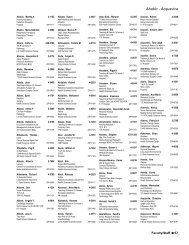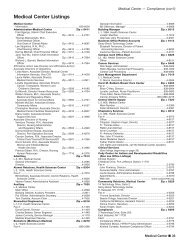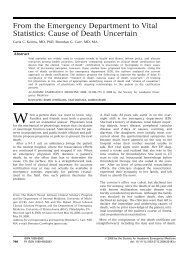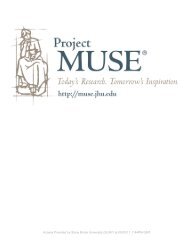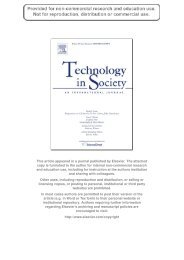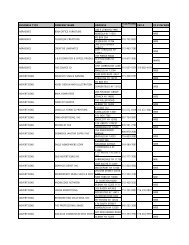2010 Abstracts - Stony Brook University
2010 Abstracts - Stony Brook University
2010 Abstracts - Stony Brook University
You also want an ePaper? Increase the reach of your titles
YUMPU automatically turns print PDFs into web optimized ePapers that Google loves.
— <strong>2010</strong> REU PHYSICS & ASTRONOMY, STONY BROOK UNIVERSITY ―<br />
CONTENTS<br />
INTRODUCTION ............................................................................................................................................................1<br />
CREATING UNCONVENTIONALLY POLARIZED BEAMS USING<br />
STRESS BIREFRINGENT WAVE PLATES<br />
Jacob Chamoun, Marty Cohen, John Noé....................................................................................................................2<br />
THE SILICON VERTEX TRACKER UPGRADE PROJECT<br />
Andriy Dotsenko, Philippe Castera, Abhay Deshpande, Paul Kline, Andrew Manion, Steve Kaneti,<br />
Swadhin Taneja, Rachid Nouicer, Alan Dion, Kieran Boyle......................................................................................3<br />
SODIUM LINE STRENGTH AS SURFACE GRAVITY INDICATOR<br />
Drummond Fielding, Michal Simon ................................................................................................................................4<br />
VERIFYING THE EFFICACY OF AN ION SOURCE<br />
Simon Freedman, Daniel Pinghero, Victoria Yu, Thomas K. Hemmick, Richard Lefferts, Andrzej Lipski......5<br />
A PRECISE MEASUREMENT OF THE SPEED OF LIGHT IN AIR FROM THE<br />
FREQUENCY SEPARATION OF LONGITUDINAL MODES IN AN OPEN-CAVITY HeNe LASER<br />
Vince Gregoric, Marty Cohen, Sam Goldwasser, John Noé ...................................................................................6<br />
MODE-LOCKING A HENE LASER BY EXTRA-CAVITY ACOUSTO-OPTIC MODULATION<br />
Ewuin Guatemala, Martin Cohen, John Noé................................................................................................................7<br />
OBSERVING THE PANCHARATNAM-BERRY PHASE ON THE POINCARÉ SPHERE<br />
Heather Hill, Marty Cohen, John Noé ..........................................................................................................................8<br />
TESTING AND USING A MODERN 1D STELLAR EVOLUTION CODE<br />
Max Katz, Michael Zingale ...............................................................................................................................................9<br />
OPTICAL DESIGN CONSIDERATIONS FOR A NEGATIVE ION SOURCE<br />
Daniel Pinghero, Simon Freedman, Victoria Yu, Rich Lefferts, Thomas Hemmick ...........................................10<br />
CREATING A SWITCHABLE DIFFRACTION GRATING IN A LIQUID CRYSTAL CELL<br />
Ekaterina Sergan, John Noé...........................................................................................................................................11<br />
POTENTIAL ENERGY COMPARISONS BETWEEN AB INITIO WATER SIMULATIONS<br />
AND CLASSICAL ANALOGS<br />
Spencer Thomas , Marivi Fernandez-Serra.................................................................................................................12<br />
DESIGN OF A SAMPLE CHANGING ION SOURCE<br />
Victoria Yu, Daniel Pinghero, Simon Freedman, Richard Lefferts, Thomas K. Hemmick ................................13<br />
INDEX OF REU-UNDERGRADUATE CONTRIBUTORS ................................................................................................15
— <strong>2010</strong> REU PHYSICS & ASTRONOMY, STONY BROOK UNIVERSITY ―<br />
INTRODUCTION<br />
<strong>Stony</strong> <strong>Brook</strong> <strong>University</strong> is proud to host the Research Experiences for Undergraduates (REU) Program<br />
in Physics & Astronomy. Sponsored by the National Science Foundation (NSF), this program gives<br />
undergraduate students an intensive hands-on research experience and involves them in all phases of the<br />
research process. This year, twelve summer researchers from colleges and universities throughout the<br />
country were selected from a select pool of over three hundred applicants. In carrying out their<br />
projects, REU participants worked alongside <strong>Stony</strong> <strong>Brook</strong>’s faculty, post-docs, graduate students and<br />
other undergraduates. The summer activities culminated in a presentation of the students’ work in a<br />
research symposium and in a written report.<br />
As you read this collection of their abstracts, you will see evidence of their hard work, keen insight and<br />
enthusiasm, and be impressed at what they have accomplished in only eight weeks.<br />
I have no doubt that these individuals will continue on with successful academic and research careers.<br />
—Erlend Graf, Director, REU Physics & Astronomy program, <strong>Stony</strong> <strong>Brook</strong> <strong>University</strong><br />
1
— <strong>2010</strong> REU PHYSICS & ASTRONOMY, STONY BROOK UNIVERSITY ―<br />
Jacob Chamoun<br />
Cornell <strong>University</strong><br />
Creating unconventionally polarized beams using stress birefringent wave plates<br />
Jacob Chamoun, Cornell <strong>University</strong>, MARTY COHEN and JOHN NOÉ, Laser Teaching Center,<br />
Department of Physics & Astronomy, <strong>Stony</strong> <strong>Brook</strong> <strong>University</strong><br />
This project investigated the use of a wave plate with spatially varying birefringence to produce<br />
cylindrical vector beams (CVBs), as suggested by the work of Spilman and Brown [1]. Birefringence is a<br />
property of materials in which incident polarized light is decomposed into two orthogonally polarized<br />
components ‐ the ordinary and extraordinary ray ‐ upon entry into the material. Because each ray travels<br />
at a different speed, a phase shift is incurred upon exiting the material. If the shift is 180 degrees, the<br />
material constitutes a half‐wave plate and will rotate the polarization of linearly polarized light. In stressinduced<br />
birefringence, the fast and slow axes line up with the directions of principle stress, so a planar,<br />
inhomogeneous stress pattern can produce a wave plate whose fast axis orientation varies in space. These<br />
wave plates can be used to create unconventional polarization states, including cylindrical vector beams.<br />
CVBs are propagating solutions to the vector paraxial Helmholtz equation which contain a central<br />
polarization singularity. Such beams are of both theoretical and practical interest.<br />
Spilman and Brown [1] mention a ʺdiscreteʺ wave plate composed of an angular arrangement of<br />
8 half‐wave plate wedges such that the fast axis rotates or ʺcounterrotatesʺ [1] at half the rate of the<br />
azimuthal angle. We made several such plates using birefringent transparency film and observed that the<br />
discrete wave plates rotated linearly polarized light in a way consistent with a discrete approximation to<br />
radially or azimuthally polarized light. Next, we built a stress‐optical element (SOE) based on the<br />
previous work [1,2] to apply adjustable compressive stresses at 120 o intervals around the perimeter of a<br />
1/2 in. diameter, 3/8 in. thick plexiglass window. Spilman and Brown [1] calculated that such a stress<br />
pattern would produce a counterrotating fast axis — the continuous analog to the discrete plate — which<br />
could be used to produce a truly radial or azimuthally polarized beam. We chose plexiglass over glass<br />
[1,2] because its stress‐optic coefficient is higher, so less compression is needed.<br />
When we used an expanded green (532 nm) laser beam to illuminate our SOE between linear or<br />
circular polarizers, interesting polarization structures appeared. Between circular polarizers, the SOE<br />
exhibited a single dark ring of half‐wave retardance. With the ring isolated by an annular mask, exposing<br />
the SOE to linearly polarized illumination and analyzing with a linear analyzer produced dark lobes that<br />
rotated with the analyzer, indicating the presence of a polarization vortex. A series of images of the SOE<br />
between various combinations of polarizer and analyzer were taken with a consumer camera and<br />
analyzed in MATLAB to extract the spatial pattern of Stokes parameters. This analysis confirmed that<br />
there is an annular region of counterrotating linear polarization at the half‐wave radius. We are currently<br />
taking additional images with a more appropriate computer‐based camera.<br />
This work was supported by the National Science Foundation (Phy‐0851594).<br />
[1] A. K. Spilman, T. G. Brown, Appl. Opt. 46, 61‐66 (2007)<br />
[2] A. K. Spilman, ʺStress‐engineered optical elementsʺ. PhD thesis. <strong>University</strong> of Rochester. (2007)<br />
2
— <strong>2010</strong> REU PHYSICS & ASTRONOMY, STONY BROOK UNIVERSITY ―<br />
The Silicon Vertex Tracker upgrade project<br />
Andriy Dotsenko, Philippe Castera, ABHAY DESHPANDE, Paul Kline, Andrew Manion,<br />
Steve Kaneti, Swadhin Taneja, Department of Physics & Astronomy, <strong>Stony</strong> <strong>Brook</strong> <strong>University</strong>,<br />
Rachid Nouicer, <strong>Brook</strong>haven National Laboratory; Alan Dion, Iowa State <strong>University</strong>;<br />
Kieran Boyle, RIKEN BNL Research Center<br />
Andriy Dotsenko<br />
<strong>Stony</strong> <strong>Brook</strong> <strong>University</strong><br />
The Relativistic Heavy Ion Collider (RHIC) is a powerful instrument for (spin, heavy ion/particle)<br />
physics. Since its first run in 2000 RHIC has observed the formation a dense nuclear matter called quarkgluon<br />
plasma (QGP) in energetic gold+gold nuclei collisions and has shown that gluons contribute very<br />
little to the spin of the proton. As new discoveries are made and as technology advances the RHIC<br />
detector systems undergo periodic upgrades. These upgrades allow us to gain an ever improving<br />
understanding of the QGP and the proton’s spin constitution. The latest upgrade to be made to PHENIX,<br />
one of the two large detectors at RHIC, will be the addition of the Silicon Vertex Tracker (VTX). The VTX<br />
can resolve the decay vertices of heavy quark carrying particles. PHENIX can use the VTX to track heavy<br />
mesons traversing through the QGP which will render great insight into its properties. The purpose of<br />
this project was to work with a team of professionals in assembly and testing of the VTX.<br />
The VTX consists of four concentric barrels of silicon detectors. The responsibility of my lab is to<br />
assemble and test the outer two barrels consisting of novel Strip Pixel sensors used for the first time for<br />
particle tracking. The barrels are made of chains of sensors assembled into ladders. After the sensors are<br />
precisely attached to the ladders, they are rigorously tested for quality. Routine tests tell us if dead<br />
channels are present as well as the noise signature of live channels. The ladders will undergo a final beta<br />
source test before being assembled into barrels. As we assemble and test the ladders, various precautions<br />
are taken to protect the sensors from static electricity discharges, dust, moisture, and human touch.<br />
The project follows strict deadlines in order to finish the detector before Run 11 of RHIC in the winter<br />
of <strong>2010</strong>‐2011. Presently, all the ladders have been assembled and tested and await the final packaging as<br />
well as the beta source test.<br />
This work was supported by the REU Physics program at <strong>Stony</strong> <strong>Brook</strong> <strong>University</strong>, and the National<br />
Science Foundation (PHY–0851594).<br />
3
— <strong>2010</strong> REU PHYSICS & ASTRONOMY, STONY BROOK UNIVERSITY ―<br />
Sodium line strength as surface gravity indicator<br />
Drummond Fielding<br />
Johns Hopkins <strong>University</strong><br />
Drummond Fielding, Johns Hopkins <strong>University</strong>; MICHAL SIMON, Department of Physics & Astronomy,<br />
<strong>Stony</strong> <strong>Brook</strong> <strong>University</strong><br />
The motivation of this research was to develop a technique for estimating the age of stars a few tenths<br />
of the mass of the sun. This is useful to us because conventional youth indicators are not reliable for low<br />
mass (< 1 Solar Mass), young (< 50 million years old) stars. The stars we focused on are limited to a region<br />
of ~100pc around the sun because, although low mass stars are very numerous, they also have low<br />
luminosity. Young stars in the solar neighborhood are sometimes found in groups of stars of the same<br />
age moving together through the galaxy. We focused on the β Pictoris Moving Group (BPMG), which is<br />
spread throughout the sky so determining membership cannot rely on position and an observable age<br />
indicator is needed. We used surface gravity, g = G M*/R*2, as a proxy for age since a young star decreases<br />
in radius as it collapses to its stable configuration as a main sequence star. We studied the use of the<br />
Na I doublets at 5890 and 5896 Å (Na D line) and at 8183 and 8195 Å (~8200 Å line) as surface gravity<br />
indicators for late K and M spectral type stars. I wrote several procedures in IDL to calculate the<br />
equivalent width (EW) of large number of observed spectra at different resolution and modeled<br />
theoretical spectra at very high resolution. By calculating the EWs of these doublets we show the<br />
demonstrated relation between EW of the spectral lines and the logarithm of the surface gravity, log(g).<br />
We found that for the Na D lines there is a clear distinction between known giant and main sequence<br />
dwarf stars; and that known and likely BPMG members lay in between but close to the main sequence<br />
stars. For the 8200 lines we found that the EWs are smaller but follow the same pattern. By choosing<br />
model spectra that corresponded to specific effective temperature and log(g), and comparing their EW<br />
with the EW of candidate BPMG stars and known stars of different sizes, masses, and ages, we<br />
demonstrated that EWs of the sodium doublets are a youth indicator.<br />
This work was supported by a grant from the National Science Foundation (PHY–0851594).<br />
4
— <strong>2010</strong> REU PHYSICS & ASTRONOMY, STONY BROOK UNIVERSITY ―<br />
Simon Freedman<br />
Illinois Institute of Technology<br />
Verifying the efficacy of an ion source<br />
Simon Freedman, Illinois Institute of Technology; Daniel Pinghero, Clarkson <strong>University</strong>; Victoria Yu,<br />
Rutgers <strong>University</strong>; THOMAS K. HEMMICK, Richard Lefferts, Andrzej Lipski, Center for Accelerator Science and<br />
Education (CASE), Department of Physics & Astronomy, <strong>Stony</strong> <strong>Brook</strong> <strong>University</strong><br />
Accelerator mass spectrometry (AMS) is a technique of measuring the mass content of an unknown<br />
sample to a high degree of accuracy using a particle accelerator. This involves creating a beam of negative<br />
ions whose velocity and direction can be manipulated by placing electric and magnetic fields of varying<br />
magnitude in their way. This work involved designing a relatively inexpensive negative ion beam source<br />
for the Van de Graaff tandem accelerator used in the Center for Accelerator Science and Education<br />
(CASE) that would be capable of producing a large amount of beam, while providing a mechanism for<br />
changing samples that does not require recalibrating the whole device. It was necessary to construct a test<br />
stand to evaluate the performance of the new ion source.<br />
In order to generate an ion beam that accurately reflects the contents of the sample being analyzed,<br />
it is necessary to maintain high vacuum<br />
within the test stand. The components of<br />
the test stand were thus sealed with Conflat, Dependex, and O‐ring joints. The beam line was pumped<br />
down to the millitorr range using a roughing pump, and reached a minimum of<br />
using a<br />
turbo pump.<br />
Although the initial acceleration of the beam is performed within the ion source itself, an Einzel lens<br />
with a variable voltage was attached to the test stand in order to keep the beam from becoming too wide<br />
(and hence missing the target) while traveling down the beam line of the test stand. Additionally,<br />
a magnetic dipole with a variable current was placed over a pipe in the test stand to prevent the beam<br />
from veering off course laterally.<br />
Detection of the beam was accomplished by placing a quartz plate in the beam‐line that would<br />
phosphoresce when hit by the beam. The intensity of the beam was measured by placing a Faraday cup in<br />
the test stand capable of measuring the beam’s current. The test stand was implemented using an ion<br />
source of the same model as currently exists on the tandem accelerator. A bluish spot was seen whose<br />
radius would change depending on the voltage placed on the Einzel lens. Additionally, the current<br />
measured in the Faraday cup reached a maximum of , which is the same order of magnitude of<br />
how much beam is necessary to perform AMS. These preliminary results indicate that this test stand will<br />
be able to validate the performance of our new ion source.<br />
This work was supported by a grant from the National Science Foundation (PHY‐0851594), as well as<br />
funding for the Center for Accelerator Science and Education (CASE) at <strong>Stony</strong> <strong>Brook</strong> <strong>University</strong>.<br />
5
— <strong>2010</strong> REU PHYSICS & ASTRONOMY, STONY BROOK UNIVERSITY ―<br />
Vincent Gregoric<br />
Mount Union College<br />
A precise measurement of the speed of light in air from the frequency separation<br />
of longitudinal modes in an open-cavity HeNe laser<br />
Vince Gregoric, Mount Union College; MARTY COHEN, SAM GOLDWASSER, and JOHN NOÉ,<br />
Laser Teaching Center, Department of Physics & Astronomy, <strong>Stony</strong> <strong>Brook</strong> <strong>University</strong><br />
This project was motivated by an interest in the longitudinal modes of laser cavities, which are<br />
similar to standing wave harmonics on a string fixed on both ends in that the allowed modes are those in<br />
which an integer number of half‐wavelengths exactly ʹfitʹ within the laser cavity. From this condition, the<br />
frequencies of adjacent longitudinal modes are ideally separated by c/2nL where c is the speed of light, n<br />
is the refractive index of the medium in the cavity, and L is the cavity length. Thus by measuring the beat<br />
frequency between two adjacent longitudinal modes and the cavity length, one can in principle determine<br />
the speed of light.<br />
DʹOrazio et al. [1] have recently described an experiment which uses this general concept to<br />
determine the speed of light with enough precision to differentiate between its value in air and in<br />
vacuum. The key feature of their method is to use an open‐cavity laser with a movable output coupler<br />
(OC) mirror. It is then sufficient to determine the intermode beat frequency as a function of the precise<br />
mirror position relative to some fixed reference point, rather than the absolute total cavity length. The<br />
light velocity obtained in the analysis depends on the index of refraction of the ambient air but not that of<br />
the laser gain medium and Brewster window within the laser cavity. Finally, as discussed in Ref. [1], the<br />
exact separation between two adjacent longitudinal modes can be effected by frequency ʺpullingʺ and<br />
ʺpushing.ʺ These effects can be minimized by using a scanning Fabry‐Perot interferometer to monitor and<br />
then adjust both the absolute and relative intensities of the longitudinal modes.<br />
Our experimental setup was similar to that described in Ref. [1]. The main modification was taking<br />
length measurements closely spaced over approximately 2 cm as opposed to the larger range of 16 cm<br />
used in Ref. [1]. We also determined distances from the micrometer driving the translation stage on<br />
which the OC mirror was mounted, rather than by using a separate caliper. The beam from our open<br />
cavity HeNe laser (λ = 632.8 nm) was directed by a beam splitter into both a photodiode connected to an<br />
RF spectrum analyzer (HP model 8566A) and a scanning Fabry‐Perot interferometer connected to an<br />
oscilloscope. The spectrum analyzer was used to measure the precise beat frequency between adjacent<br />
modes, while the Fabry‐Perot was used to monitor the mode intensities. Two complete sets of data were<br />
taken, one with and one without using the Fabry‐Perot to minimize frequency pulling/pushing effects. It<br />
was apparent from the results that frequency pulling and pushing does in fact have a significant effect on<br />
the observed beat frequency for a given cavity length. Our final result for the speed of light in air was<br />
2.9973 x10 8 m/s. This result is comparable to that obtained in Ref. [1]. The accepted value of the speed of<br />
light is 2.9979 x10 8 m/s in vacuum and 2.9971 x10 8 m/s in air at standard temperature and pressure. We<br />
are currently seeking to determine the error in our final result by analyzing the uncertainties in the length<br />
and frequency measurements.<br />
This research was supported by a grant from the National Science Foundation (PHY‐0851594).<br />
[1] D. J. DʹOrazio et al., Am. J. Phys. 78, pgs 524‐528 (May <strong>2010</strong>).<br />
6
— <strong>2010</strong> REU PHYSICS & ASTRONOMY, STONY BROOK UNIVERSITY ―<br />
Mode-locking a HeNe laser by extra-cavity acousto-optic modulation<br />
Ewuin Guatemala<br />
<strong>Stony</strong> <strong>Brook</strong> <strong>University</strong><br />
Ewuin Guatemala, MARTY COHEN and JOHN NOÉ, Laser Teaching Center, Department of Physics &<br />
Astronomy, <strong>Stony</strong> <strong>Brook</strong> <strong>University</strong><br />
This project was motivated by an interest in the interaction between light and sound (acousto‐optics)<br />
and in longitudinal laser modes. In this work we have demonstrated mode locking in a helium‐neon laser<br />
through the use of an AO modulator placed outside the laser cavity, as suggested in Ref. [1]. Modelocking<br />
of a laser occurs when the longitudinal cavity modes oscillate in phase. These modes generally<br />
oscillate with a random phase relationship but when in phase the laser will output pulses of higher peak<br />
intensity than the time‐average intensity. A setup incorporating an AO modulator (AOM) can provide<br />
the frequency and phase shifts necessary to satisfy the mode‐locking condition. In an AOM a propagating<br />
acoustic wave results in a traveling refractive index grating. The first order diffracted light is frequency<br />
shifted by the frequency of sound propagating in the crystal.<br />
Our HeNe laser (Spectra Physics model 127) supports 8‐11 longitudinal modes; it has a mode spacing<br />
of 160 MHz and a cavity length L = 93.7 cm. The laser beam is incident at the Bragg angle on an Isomet<br />
AOM (model 1205C‐2‐804B) driven at half the mode spacing frequency. The first diffracted order is<br />
reflected back through the AOM to be further frequency shifted to 160 MHz and re‐diffracted back into<br />
the laser cavity creating side band modes adjacent to the cavity modes. The optical path length (OPL)<br />
between the laserʹs output mirror and the reflecting mirror is controlled by placing the latter on a<br />
micrometer translation stage. This external cavity distance must be carefully matched to the OPL of the<br />
laser cavity. By setting this distance and the AOM frequency, the AO generated sidebands are coupled to<br />
the cavity modes, locking these in phase. The zero order beam is reflected to a beam splitter, which<br />
directs it to a Fabry‐Perot analyzer and a fast Si photodetector (Thorlabs DET‐210) connected to an<br />
oscilloscope (Tektronix 485) or spectrum analyzer (HP 8566A).<br />
The spectrum analyzer was used to tune the sidebands to coincide with the cavity mode spacing;<br />
mirror adjustments resulted in shorter pulses with higher peak intensity. The pulses had the expected 160<br />
MHz spacing and a peak pulse amplitude four times higher than the time‐average intensity. Further<br />
refinements to the experiment will be aimed at finding the optimal external cavity length. This is<br />
complicated by mechanical instability of the mirror mount, which is very sensitive to vibrations. We hope<br />
to achieve stronger phase locking, resulting in pulse width values more consistent with theory, which<br />
predicts subnanosecond pulses.<br />
We would like to thank Rich Migliaccio (East Coast Optical Technologies) for providing the Spectra<br />
Physics laser and Sam Goldwasser for providing the FP analyzer. This work was funded by URECA and<br />
by NSF‐REU (grant no. PHY‐0851594).<br />
References<br />
[1] R.J. Jones. ʺActive Modelocking of a Helium‐Neon Laser.ʺ Opti‐511L course at the <strong>University</strong> of<br />
Arizona, http://www.optics.arizona.edu/opti511l/2009_files/modelocking_Fall2009.pdf<br />
7
— <strong>2010</strong> REU PHYSICS & ASTRONOMY, STONY BROOK UNIVERSITY ―<br />
Observing the Pancharatnam-Berry phase on the Poincaré sphere<br />
Heather Hill, Duke <strong>University</strong>; MARTY COHEN and JOHN NOÉ, Laser Teaching Center,<br />
Department of Physics & Astronomy,<strong>Stony</strong> <strong>Brook</strong> <strong>University</strong><br />
Heather Hill<br />
Duke <strong>University</strong><br />
In 1984, Michael Berry discovered a geometric phase in quantum systems [1], which soon led to a whole<br />
new understanding of the importance of geometric phases in other fields. In particular, an optical<br />
phenomenon that had been discovered earlier by Pancharatnam [2] was realized to be a manifestation of a<br />
geometric phase. The Pancharatnam‐Berry phase is the phase change that a monochromatic beam of light<br />
gains in a cyclic change in polarization. If one maps out the changes in polarization on the Poincaré sphere,<br />
this phase change is equal to half of the solid angle that the polarization trajectory traces out on the sphere.<br />
We hope to observe and measure the Pancharatnam‐Berry phase with an apparatus inspired by van<br />
Dijk et al. [3]. We will start with vertical linearly‐polarized light (Point A on the equator of Poincaré sphere)<br />
and pass this through a quarter‐wave plate to create circularly polarized light (Point B at the north or south<br />
pole). A linear polarizer at some angle α to the vertical will then move this polarization state to another<br />
point C on the equator. Finally, a second linear polarizer will restore the light to its original state, point A.<br />
The experiment consists of comparing the relative phase of the initial and final polarization states in a<br />
Mach‐Zehnder interferometer. We should observe that the fringe shift as a function of α varies in<br />
proportion to the solid angle mapped out on the Poincaré sphere.<br />
We found a number of unspecified quarter‐wave plates in the lab and tested them to see which ones<br />
were effective at 632.8 nm wavelength. With careful adjustments, the best of these produces good quality<br />
circularly polarized light from the beam of our linearly polarized HeNe laser. The interferometer was set up<br />
and crisp fringes were obtained; the fringes are susceptible to air currents, mechanical vibrations, etc, but<br />
with care are sufficiently stable when the room is quiet.<br />
Data taking will consist of recording the shift in fringe position while changing the first linear polarizer<br />
from α = 0 to other values α < 180°. The Pancharatnam‐Berry phase is largest (π/2, or 1/4 of a fringe) for<br />
α = 90°, which corresponds to moving half‐way around the equator of the Poincaré sphere. Unfortunately,<br />
as one approaches this angle the transmission of light in the active arm of the interferometer drops to<br />
zero. Our initial observations are a series of images of the fringe pattern with α cycled between 0, 35 and 70<br />
degrees. These images clearly show the expected geometric phase.<br />
We thank T. van Dijk and Prof. T. D. Visser for their helpful responses to our emails. This research was<br />
supported by a grant from the National Science Foundation (Phy‐0851594).<br />
[1] M. V. Berry, Proc. R. Soc. Lond. A 392, 45 (1984).<br />
[2] S. Pancharatnam, Proc. Indian Acad. Sci. A 44, 247 (1956).<br />
[3] T. van Dijk, H.F. Schouten, W. Ubachs and T.D. Visser, Proc. SPIE 7613 (<strong>2010</strong>).<br />
[4] T. van Dijk, personal communication.<br />
8
— <strong>2010</strong> REU PHYSICS & ASTRONOMY, STONY BROOK UNIVERSITY ―<br />
Testing and using a modern 1D stellar evolution code<br />
Maximilian Katz<br />
Rensselaer Polytechnic <strong>University</strong><br />
Max Katz, Rensselaer Polytechnic Institute; MICHAEL ZINGALE, Department of Physics & Astronomy,<br />
<strong>Stony</strong> <strong>Brook</strong> <strong>University</strong><br />
The majority of what we know about stellar evolution has come from the use of one‐dimensional<br />
computer codes which simulate such evolution. The standard codes, though, were written decades ago<br />
and can no longer efficiently utilize the multi‐core processors which have become the standard today.<br />
The new project, Modules for Experiments in Stellar Astrophysics (MESA), is designed to combine<br />
efficient, modern code capable of true parallel processing, with the latest theoretical developments in<br />
stellar astrophysics. Although the most complex problems in the field can only be fully understood in<br />
multiple dimensions, many problems can at least be qualitatively understood through 1D simulations,<br />
and the relative savings in computational time usually justify this. In this regard, we found several areas<br />
in which MESA can be useful.<br />
White dwarfs are the remnants of stars like the Sun; they are cool, compact stars which have roughly<br />
the mass of the Sun in an object the size of the Earth. When these have companion stars which eject<br />
matter in a stellar wind, the ejected mass can be accreted onto the surface of the white dwarf, and in<br />
many cases, this can lead to nuclear fusion, and possibly a thermonuclear runaway (nova), of the accreted<br />
material. MESA was used to simulate novae on a carbon/oxygen white dwarf. While complete<br />
understanding of these events requires multi‐dimensional simulations, such simulations require good<br />
initial models. Since it is too expensive to run through the majority of the process in two or three<br />
dimensions, we used MESA to generate initial models sufficient for use in these more complex codes. It<br />
was found that these models are much more resolved than models generated in older codes.<br />
Additionally, it is important to know which nuclei are important in the nuclear reactions in the nova;<br />
keeping track of isotopes which do not play a significant part in the physics is simply too expensive. It<br />
was found that the proton‐proton reaction chain, although important in the interior of stars like the Sun,<br />
is unimportant in typical novae; rather, the carbon‐nitrogen‐oxygen (CNO) process is responsible for the<br />
majority of hydrogen burning in these events. We also found particular isotopes in certain reaction<br />
channels that play relatively important parts in the dynamics, and were able to isolate only the ones<br />
which truly contribute to the nova.<br />
Additionally, MESA was used to study the ratio of carbon to oxygen, by mass, in these white dwarfs.<br />
Stars with varying initial metallicity were simulated from the beginning of the main sequence to nearly<br />
the end of the asymptotic giant branch. It was found that in general there is a decline in the C/O ratio<br />
with initial metallicity, although there are exceptions in some cases.<br />
This work was supported by a grant from the National Science Foundation (PHY–0851594).<br />
9
— <strong>2010</strong> REU PHYSICS & ASTRONOMY, STONY BROOK UNIVERSITY ―<br />
Optical design considerations for a negative ion source<br />
Daniel Pinghero<br />
Clarkson <strong>University</strong><br />
Daniel Pinghero, Clarkson <strong>University</strong>; Simon Freedman, Illinois Institute of Technology; Victoria Yu, Rutgers<br />
<strong>University</strong>; Rich Lefferts and THOMAS HEMMICK, Department of Physics & Astronomy, <strong>Stony</strong> <strong>Brook</strong> <strong>University</strong><br />
A new negative ion source is to be designed to bring full Accelerator Mass Spectometry (AMS) capabilities to<br />
<strong>Stony</strong> <strong>Brook</strong> <strong>University</strong>. The new ion source, to be designed in conjunction with a sophisticated sample switching<br />
apparatus, is based on the Purdue <strong>University</strong> PRIME source. The design features a spherical ionizer made of<br />
molybdenum. As is common to all cesium sputter ion sources, cesium vapor will be allowed to strike the heated<br />
ionizer surface, causing Cs+ ions to form and accelerate toward the sample opposite the ionizer due to the<br />
differences in electrical potential. The desired target area of these ions is very small; a circle of one millimeter<br />
diameter was the goal for this design. As in traditional optics, a spherical lens does not focus parallel beams (or<br />
cesium ions) optimally —a range of foci are created based on the distance of the ion from the central axis of the<br />
lens. It is desirable that all the cesium focus at the same point — on the sample — and so an additional optical<br />
element is required to correct for the spherical aberration. This element, the “shroud,” will be a custom built piece<br />
of stainless steel, thermally isolated from the ionizer but at the same electrical potential; the shroud will provide<br />
electric field correction but will not contribute significantly to the cesium ion production due to its low<br />
temperature. To further reduce the diffuse focusing of the lone ionizer, the body of the ionizer will be machined to<br />
a less spherical shape.<br />
In addition to its optical benefits, the shroud will allow for more optimal placement of the cesium<br />
expulsion vents. Not all cesium atoms will ionize upon initial contact with the ionizer; introducing the cesium<br />
in a manner inducing several contacts, (similar to the bounces of a billiard ball) is desired. The shape of the<br />
shroud will allow the vents to send the neutral cesium vapor on trajectories that are likely to intersect the<br />
ionizer body up to four times (thus allowing four independent chances for ionization) before it enters the<br />
vacuum at random.<br />
A second correctional optical element is also required for the new ion source. The produced negative ion<br />
beam must fit through the ionizer’s central hole (about 2.5 mm in radius). Without any correction, the initial<br />
one millimeter beam will diverge too greatly — further focusing of the beam will be required. To accomplish<br />
this, a thin circular plate of stainless steel, with a radius of just less<br />
than 4 mm will be placed just in front of the sample holder, and<br />
raised to a slightly less negative potential. This “immersion lens”<br />
has a negligible effect on the positive cesium ions, as their energy<br />
is quite high by the time they reach this element, but it provides<br />
sufficient focusing of the negative ion beam.<br />
These elements were modeled on a computer using<br />
SIMION 8.0, an ion trajectory calculation program. A cross<br />
section of the cylindrically symmetric design is displayed in<br />
figure one. The combination of shroud design and ionizer<br />
alterations allow for slightly greater than 80% of cesium ions to<br />
hit the above described 1 mm target on the sample, and all of the<br />
resulting negative ions to emerge through the ionizer in a well<br />
focused beam.<br />
This work was supported by a grant from the National<br />
Science Foundation (PHY ‐ 0851594).<br />
Figure 1 – Cross Sectional View of Interior of Ion Source<br />
10
— <strong>2010</strong> REU PHYSICS & ASTRONOMY, STONY BROOK UNIVERSITY ―<br />
Katya Sergan<br />
<strong>University</strong> of California, Davis<br />
Creating a switchable diffraction grating in a liquid crystal cell<br />
Ekaterina Sergan, <strong>University</strong> of California, Davis, JOHN NOÉ, Laser Teaching Center, Department of Physics &<br />
Astronomy, <strong>Stony</strong> <strong>Brook</strong> <strong>University</strong><br />
This project focused on the study of polymer stabilized liquid crystals (LCs).<br />
Nematic LCs are birefringent rod‐shaped molecules that respond to an electric field. In our case, the<br />
applied field polarizes the molecules along their long molecular axis and re‐orients them along the field<br />
direction. Creating a polymer network at the boundaries of an LC cell disables the ability of the LC<br />
molecules to respond in this way. If the polymer network is periodic, then a voltage‐controlled grating<br />
can be created. The polymer network is formed by irradiating the cell with a wavelength of light that<br />
activates the photoinitiator. At the same time a relatively high voltage is applied across the cell to not<br />
only re‐orient the LC molecules but also drive the polymer precursor (monomer) to the two substrates of<br />
the cell. After the voltage is removed, the areas that were not exposed to the light relax back to their<br />
original planar orientation and a variable phase shift between the ordinary and extraordinary waves of<br />
polarized light incident normally to the cell results in a spatially varying head‐on retardation. Applying a<br />
switching voltage switches the planar areas between high and low retardation.<br />
We used LC cells (gap ~20 microns) that were filled with a mixture of an LC material, about 1% of a<br />
photo‐curable monomer, and about 0.01% of a UV (~300 nm) sensitive photoinitiator. The high voltage<br />
used was 120 VAC (rms) and the light source was a conventional RadioShack blacklight. The cell was<br />
irradiated for about 30 minutes though a mask with an approximately 50‐50 pattern and a period of<br />
slightly greater than 1.0 line/mm.<br />
The ability of the pattern to diffract light was studied by illuminating it with red light (633 nm) from<br />
an unpolarized HeNe laser. We observed a diffraction pattern that consisted of several fringes and a<br />
bright central spot. The fringe pattern changed as an AC control voltage was applied to the cell. The<br />
largest pattern (about 20 visible fringes) was observed at a peak to peak voltage of 3.00 V. The spacing in<br />
the pattern was consistent with the spacing in the mask to better than 10%. We are currently analyzing<br />
this spacing more carefully, in part to see if it is affected by the applied switching voltage. The diffraction<br />
pattern could be turned off by applying > 40 V peak‐to‐peak. From this we conclude that we did indeed<br />
create an electrically controlled diffraction grating. Some very interesting polarization effects were also<br />
observed. In one orientation of a linear polarizer only fringes could be seen, while in the perpendicular<br />
orientation only the undiffracted beam spot was visible. The polarizer had the same effect whether it was<br />
placed before or after the grating.<br />
We thank the Optics Lab at California State <strong>University</strong> Sacramento for providing the prepared LC<br />
cells. We would also like to thank T. Sergan, V. Sergan and H. Metcalf for their invaluable contributions.<br />
This work was supported by the National Science Foundation (PHY‐0851594).<br />
References:<br />
1. V. Sergan, T. Sergan, and P. Bos, Chem. Phys. Lett, 486, 123 (<strong>2010</strong>)<br />
11
— <strong>2010</strong> REU PHYSICS & ASTRONOMY, STONY BROOK UNIVERSITY ―<br />
Spencer Thomas<br />
<strong>Stony</strong> <strong>Brook</strong> <strong>University</strong><br />
Potential energy comparisons between ab initio water simulations and classical<br />
analogs<br />
Spencer Thomas and MARIVI FERNANDEZ-SERRA, Department of Physics & Astronomy, <strong>Stony</strong> <strong>Brook</strong> <strong>University</strong><br />
Despite the prodigious growth of computational power available to physicists, ab initio Molecular<br />
Dynamics Simulations (AIMDS) remain prohibitively expensive. Even for the ʺsimpleʺ water molecule<br />
(our main focus), practical simulations are generally limited to 32 to 128 molecules. Ab initio calculations<br />
are expensive by nature and scale non‐linearly with system size. Building on previous work, which<br />
determined spatial distribution functions for ab initio water simulations, we run tests on an analogous<br />
classical system.. We generate a classical potential energy landscape for a system of two water molecules<br />
and compare with analogous data from ab initio simulations.<br />
Our algorithm takes one molecule at a “standard” position on the xy plane at the origin and places<br />
another molecule at all locations (within a precision parameter) on concentric spheres around the origin.<br />
For each spatial location (measured at the oxygen atom), the minimum potential energy configuration is<br />
determined. A field of all relaxed energy values is created and optimal (minimal‐energy) locations are<br />
recorded for study. This method is repeated for the SPC/E, Tip4p, and Tip5p water charge models as well<br />
as a dipole case. A Gaussian smoothing function is applied to the discretized energy information for<br />
functional fits. Another program takes time‐averaged coordinate data from ab initio simulations and<br />
calculates Gibbs free energy for the same coordinate data. With this, we have a direct comparison<br />
between the energy predicted in ab initio simulations and our classical analog. We can also observe<br />
differences between the various electronic charge models and build a base with which to test more.<br />
Additional work by W. Cancek et al (Phys. Chem. Chem. Phys., 2008, 10, 4716‐4731) performs a direct<br />
energy analysis of ab initio models. This provides another layer of data with which to compare our<br />
relatively inexpensive classical model.<br />
This study supported by NSF Grant Phy‐0851594 and DOE award number DE‐FG02‐09ER16052.<br />
12
— <strong>2010</strong> REU PHYSICS & ASTRONOMY, STONY BROOK UNIVERSITY ―<br />
Design of a sample changing ion source<br />
Victoria Yu<br />
Rutgers <strong>University</strong><br />
Victoria Yu, Rutgers <strong>University</strong>; Daniel Pinghero, Clarkson <strong>University</strong>; Simon Freedman, Illinois Institute of<br />
Technology; Richard Lefferts, THOMAS K. HEMMICK, Department of Physics & Astronomy, <strong>Stony</strong> <strong>Brook</strong><br />
<strong>University</strong>.<br />
The primary goal of this project is to design a high‐intensity, sample‐changing negative ion source for<br />
future research in Accelerator Mass Spectrometry (AMS). This type of ion source is needed because AMS<br />
research requires rapid sample‐changing and precise positioning without vacuum disruption in order to<br />
conserve similar conditions between trials.<br />
In this design, we achieve a significantly more efficient sample‐changing mechanism by utilize a<br />
computer‐controlled and rotating, semi‐circle‐shaped sample‐holding “Dee” which contains forty<br />
holding slots arranged along its radii, the precision of which brings each sample to the desired position<br />
within the system. The Dee is placed into a lidded, vacuum‐sealed box that is connected to a rectangular<br />
gate valve. After the sample slots on the Dee are loaded, the system is pumped to vacuum and the Dee<br />
can be pivoted to bring any sample into the measurement position. When all of the intended trials on one<br />
Dee have been completed and new samples are to be placed into the system, the whole Dee can be<br />
rotated out through the gate valve and into the box, after which the gate valve will close behind it. The<br />
box can then be opened without compromising the vacuum state of the system on the other side of the<br />
gate valve. This design saves time between trials because only the volume of air in the box will need to<br />
be pumped out to re‐attain a vacuum instead of the entire system.<br />
In a negative ion source, the electrically neutral Cesium atoms gain a positive charge through contact<br />
with the heated ionizer, causing them to be propelled towards a highly negative cathode. The resulting<br />
impact releases negative ions that are accelerated by Coulomb repulsion. The ion optics, which refers to<br />
the paths of the Cesium ions and the negative ions, are both crucial to the intensity of the beam source.<br />
These paths are determined by the potential levels and distances between the ionizer, immersion lens and<br />
the cathode. SIMION 8.0 was used to model the ion optics. The most efficient combination of voltage<br />
levels, shapes and distances of all the beam steering elements was obtained. With the results from<br />
SIMION simulations, the sample changing mechanism and building onto some existing parts of an old<br />
ion source, various pieces of the ion source were designed and drawn using SolidWorks; including<br />
modifications to a commercially bought spherical ionizer, a shroud surrounding the ionizer that guides<br />
the Cesium beam to a better focus, insulating pieces to separate the different voltage levels, extraction<br />
electrode, the Dee, and the box that contains the Dee and cooling systems. More computer aided research<br />
has been conducted to make sure that this ion source would be structurally sound and achieve its desired<br />
performance once physically fabricated. A picture of some parts in the design in shown in Figure 1. The<br />
design was successfully completed and an ion source test stand was built to be used for testing when the<br />
ion source is successfully assembled.<br />
This work was supported by a grant from the National Science Foundation (PHY–0851594).<br />
13
— <strong>2010</strong> REU PHYSICS & ASTRONOMY, STONY BROOK UNIVERSITY ―<br />
14
— <strong>2010</strong> REU PHYSICS & ASTRONOMY, STONY BROOK UNIVERSITY ―<br />
INDEX OF REU-UNDERGRADUATE CONTRIBUTORS<br />
C<br />
Chamoun, Jacob · 2<br />
D<br />
Dotsenko, Andriy · 3<br />
F<br />
Fielding, Drummong · 4<br />
Freedman, Simon · 5, 10, 13<br />
G<br />
Gregoric, Vincent · 6<br />
Guatemala, Ewuin · 7<br />
H<br />
K<br />
Katz, Maximilian · 9<br />
P<br />
Pinghero, Daniel · 5, 10, 13<br />
S<br />
Sergan, Ekaterina · 11<br />
T<br />
Thomas, Spencer · 12<br />
Y<br />
Yu, Victoria · 5, 10, 13<br />
Hill, Heather · 8<br />
15
— <strong>2010</strong> REU PHYSICS & ASTRONOMY, STONY BROOK UNIVERSITY ―<br />
16



